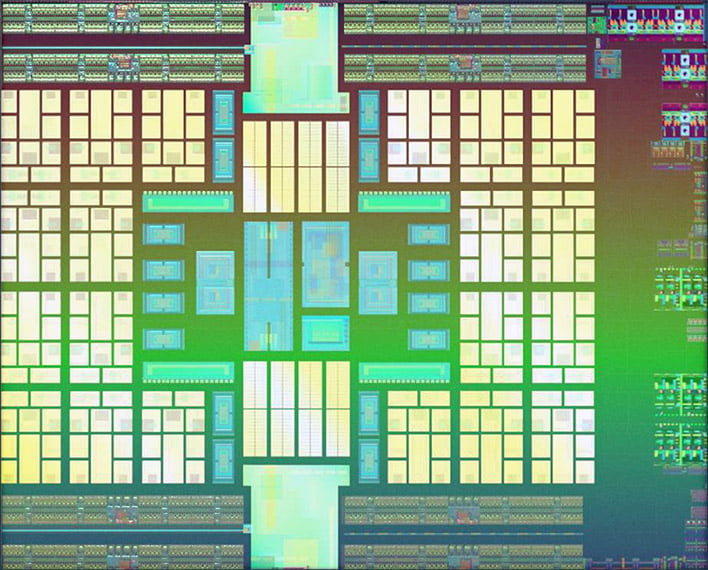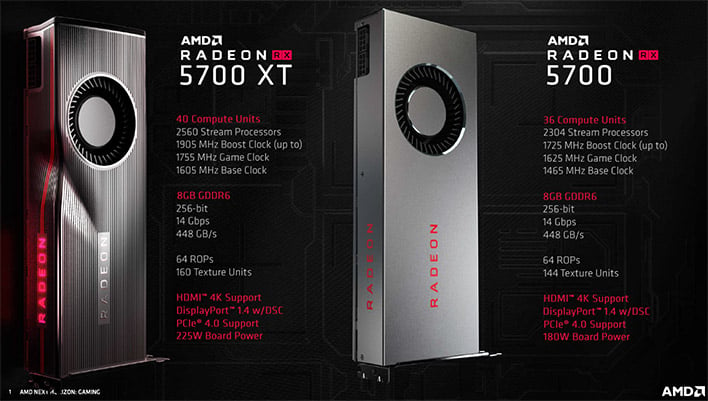AMD Radeon RX 5700 XT And RX 5700 Review: 7nm Navi Debuts
If you missed our coverage of AMD's Navi GPU architecture and its newly-designed RDNA-infused microarchitecture and instruction set, you can find it right here. We strongly suggest checking that article out, because we cover a number of deep technical details, including Navi’s new compute unit design, multi-level cache hierarchy, pervasive support for Delta Color Compression, PCI Express 4.0, and the new Radeon Multimedia Engine that can handle 8K encoding while being roughly 40% faster than the previous generation. We also cover Fidelity FX, and the AMD Radeon Anti-Lag and Radeon Image Sharpening (RIS) features in the piece. AMD Radeon Anti-Lag can effectively reduce input lag in a number of popular games and RIS is a post-processing compute shader with an intelligent contrast-aware, sharpening algorithm that can draw out details in low contrast areas of a scene, without negatively impacting image quality in high contrast scenes.
Since we’ve covered all of that previously, we won’t re-hash it all again here. Instead, we’re going to focus on the Radeon RX 5700 XT and Radeon RX 5700 cards themselves and see how they perform versus AMD’s previous-gen products and NVIDIA’s newly-released competitive offerings. Take a look at the cards and their main features and specifications below, and then we’ll break things down a little further to see how these things handle the in the benchmarks...
|
Both the Radeon RX 5700 XT and Radeon RX 5700 are built around AMD's Navi 10 GPU – a few portions of the chip are simply disabled in the RX 5700 to bring its shader count down a touch. We’ll explain exactly how the cards differ shortly, but first, let's talk about the GPU powering them, because it is an important development and the technological foundation of what will likely be a multi-year effort from AMD. In the same way that GCN (Graphics Core Next) served AMD through the course of multiple GPU releases, so too will RDNA moving forward.

Radeon RX 5700 Navi GPU Die Shot
The GPU at the heart of the Radeon RX 5700 series is manufactured using TSMC’s 7nm process node and is comprised of approximately 10.3 billion transistors. Its die size is roughly 251 square millimeters. The die size is particularly interesting because it is quite small relative to AMD’s previous-gen 14nm Vega and NVIDIA’s current-gen Turing GPUs, which are manufactured at 12nm.
Although we’ll be showing you our own numbers here soon enough, at its event last month, AMD claimed the Radeon RX 5700 XT would go toe-to-toe with the GeForce RTX 2070. The RTX 2070 is built around NVIDIA’s TU106 GPU, which features 10.8B transistors and a die size of 445 square millimeters – that’s 44% larger than Navi 10 (side note, Vega 64 was even larger at 495mm2, not including its HBM2 memory). AMD seems to have taken a somewhat conservative approach here, which is to be expected when developing a new GPU architecture on a leading-edge manufacturing process. However, should AMD’s performance claims ring true, it also shows that the company could theoretically scale things up with this current design and potentially take on some of NVIDIA’s higher-end GPUs, should AMD want to take the fight to the top of Team Green’s stack.
Of course, NVIDIA dedicates significant die area to Turing’s RT and Tensor cores, of which Navi currently has no equivalent. Incorporating some sort of dedicated hardware for accelerating Ray Tracing would obviously take up considerable die area in a future AMD GPU, but we are getting ahead of ourselves, so let's stay on task...
For now, the fight remains in the meat in the enthusiast market, with the Radeon RX 5700 XT positioned against the GeForce RTX 2070 and recently released GeForce RTX 2060 Super. Meanwhile, AMD's Radeon RX 5700 is positioned against the original GeForce RTX 2060.
A Tale Of Two Radeon RX Navi Cards
The top-end Radeon RX 5700 XT features a fully-enabled Navi 10 GPU with 40 Compute Units, each with 64 Steam Processors, for a total of 2,560. The GPU is connected to 8GB of GDDR6 memory over a 256-bit interface with an effective data rate of 14Gbps, which equates to peak memory bandwidth of 448GB/s. The Radeon RX 5700 XT’s base GPU clock is 1,605MHz, with a 1,755MHz Game Clock and 1,905 max boost clock. AMD claims during real-world gaming sessions the actual GPU clock will likely fall somewhere between the Game Clock and max boost clock, assuming thermals and power are in-check. The GPU also has 64 ROPs, 160 texture units, and a max board power of 225 watts.The AMD Radeon RX 5700’s GPU is scaled back slightly. The RX 5700 has the same memory and ROP configuration as the XT, but four CUs have been disabled and the 5700’s clock speeds are tamer as well. The Radeon RX 5700 has 36 CUs, a total of 2,304 stream processors, and base, Game and max Boost clocks of 1,465MHz, 1,625MHz, and 1,725, respectively. Max board power is a bit lower at 180 watts.
In addition to the different GPU configurations, the Radeon RX 5700 XT and RX 5700 have different cooler designs. The Radeon RX 5700 is reminiscent of the squared-off Radeon Vega designs, with a rectangular shroud and barrel-type fan situated off to the side of its heatsink. The Radeon RX 5700 XT, however, has been totally redesigned and commands more visual attention. The reference card will feature an aluminum shroud and back-plate, while the front shroud has an angled air-slot that reportedly helps optimize airflow over the heatsink to help keep the card quiet when it is idling or under a light load. There is a hefty vapor chamber, with a dense array of heatsink fins, that sits directly atop the GPU and RAM, and mates with the GPU through a graphite-based thermal interface. There is also a 7-phase, all-digital power circuit on the board to ensure ample power to the GPU.
Both the Radeon RX 5700 and 5700 XT feature 8-pin and 6-pin PCIe power feeds, which should provide plenty of headroom for overclocking. Between the PCIe slot and the supplemental feeds, 300W will be available to the Radeon RX 5700 series cards (150 + 75 + 75).
The display outputs on the Radeon RX 5700 series cards are identical as well. Both cards feature a trio of full-sized DisplayPort 1.4 (with DSC) connectors and a single HDMI port, all of which can be used at any given time for multi-monitor configurations. The remainder of the case bracket is essentially one large vent, for exhausting warm air from a system.







